Analyzing Leadership Style Impact on Staff Retention: Tesco Report
VerifiedAdded on 2020/07/22
|44
|12162
|149
Report
AI Summary
This report investigates the crucial link between leadership styles and employee retention, using Tesco as a detailed case study. The research begins with an introduction outlining the significance of leadership in staff management and retention, highlighting the challenges of employee turnover. It sets out the research aim, objectives, and questions, focusing on identifying the impact of different leadership styles such as transactional and transformational leadership on staff retention within Tesco. The study employs a qualitative research approach, gathering data through surveys administered to Tesco managers. The literature review explores the concepts of employee retention and leadership styles, examining how various leadership approaches influence retention rates. The methodology section details the research strategy, design, and data collection methods, including sampling and ethical considerations. The data analysis chapter presents the findings, interpreting the impact of leadership styles on employee retention. Finally, the conclusion summarizes the key findings and provides recommendations for Tesco to improve its staff retention strategies by optimizing leadership practices. The report emphasizes the significance of leadership in fostering a positive work environment and retaining valuable employees.
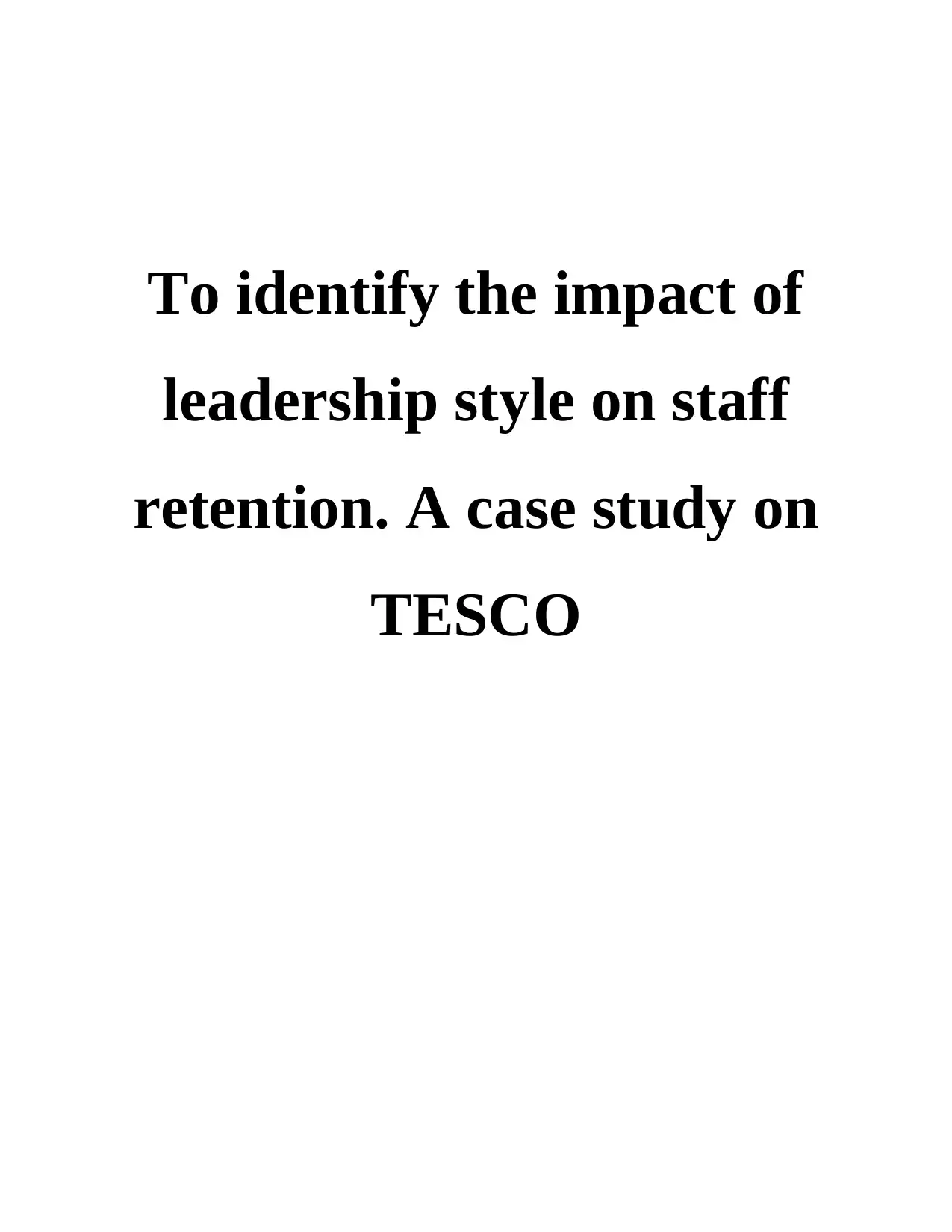
To identify the impact of
leadership style on staff
retention. A case study on
TESCO
leadership style on staff
retention. A case study on
TESCO
Paraphrase This Document
Need a fresh take? Get an instant paraphrase of this document with our AI Paraphraser

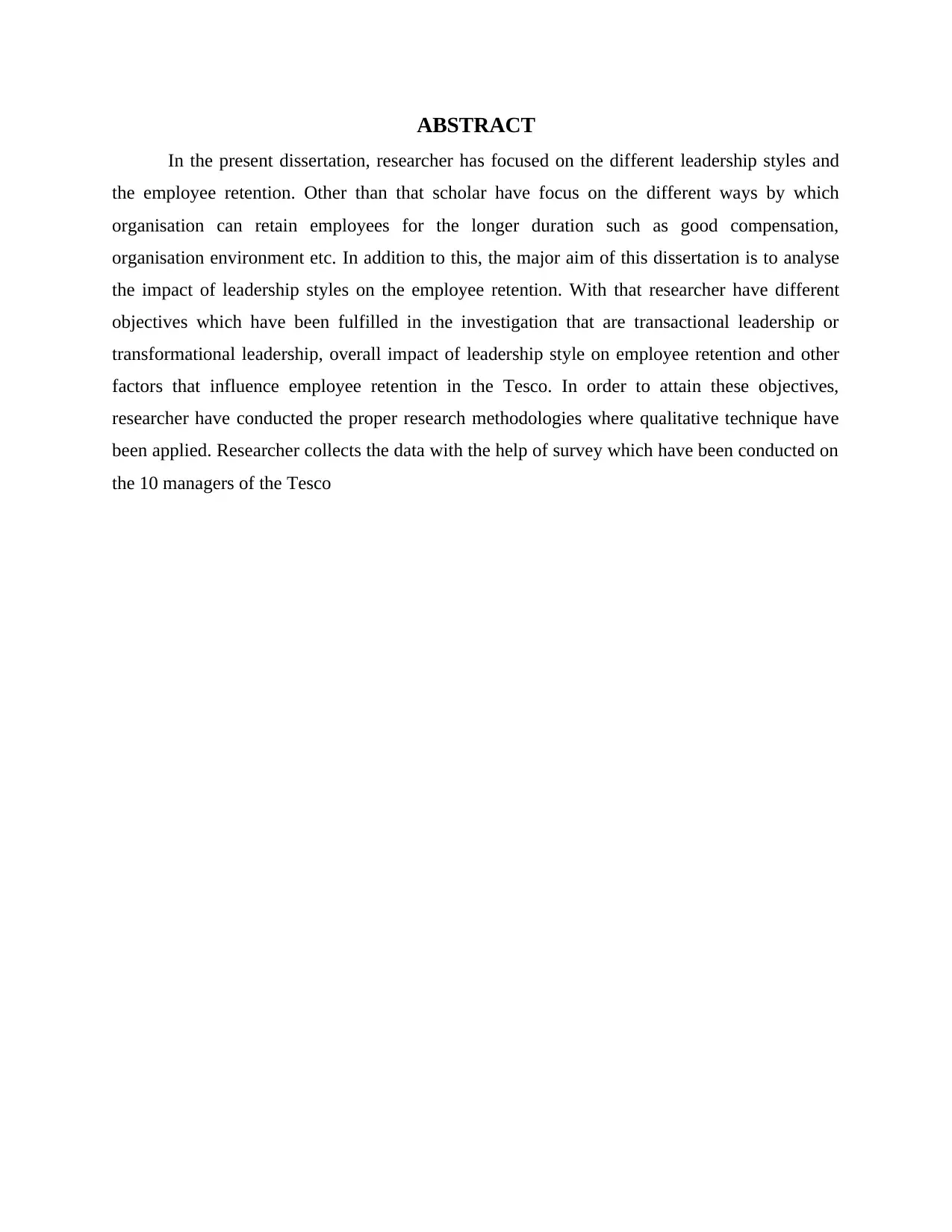
ABSTRACT
In the present dissertation, researcher has focused on the different leadership styles and
the employee retention. Other than that scholar have focus on the different ways by which
organisation can retain employees for the longer duration such as good compensation,
organisation environment etc. In addition to this, the major aim of this dissertation is to analyse
the impact of leadership styles on the employee retention. With that researcher have different
objectives which have been fulfilled in the investigation that are transactional leadership or
transformational leadership, overall impact of leadership style on employee retention and other
factors that influence employee retention in the Tesco. In order to attain these objectives,
researcher have conducted the proper research methodologies where qualitative technique have
been applied. Researcher collects the data with the help of survey which have been conducted on
the 10 managers of the Tesco
In the present dissertation, researcher has focused on the different leadership styles and
the employee retention. Other than that scholar have focus on the different ways by which
organisation can retain employees for the longer duration such as good compensation,
organisation environment etc. In addition to this, the major aim of this dissertation is to analyse
the impact of leadership styles on the employee retention. With that researcher have different
objectives which have been fulfilled in the investigation that are transactional leadership or
transformational leadership, overall impact of leadership style on employee retention and other
factors that influence employee retention in the Tesco. In order to attain these objectives,
researcher have conducted the proper research methodologies where qualitative technique have
been applied. Researcher collects the data with the help of survey which have been conducted on
the 10 managers of the Tesco
⊘ This is a preview!⊘
Do you want full access?
Subscribe today to unlock all pages.

Trusted by 1+ million students worldwide
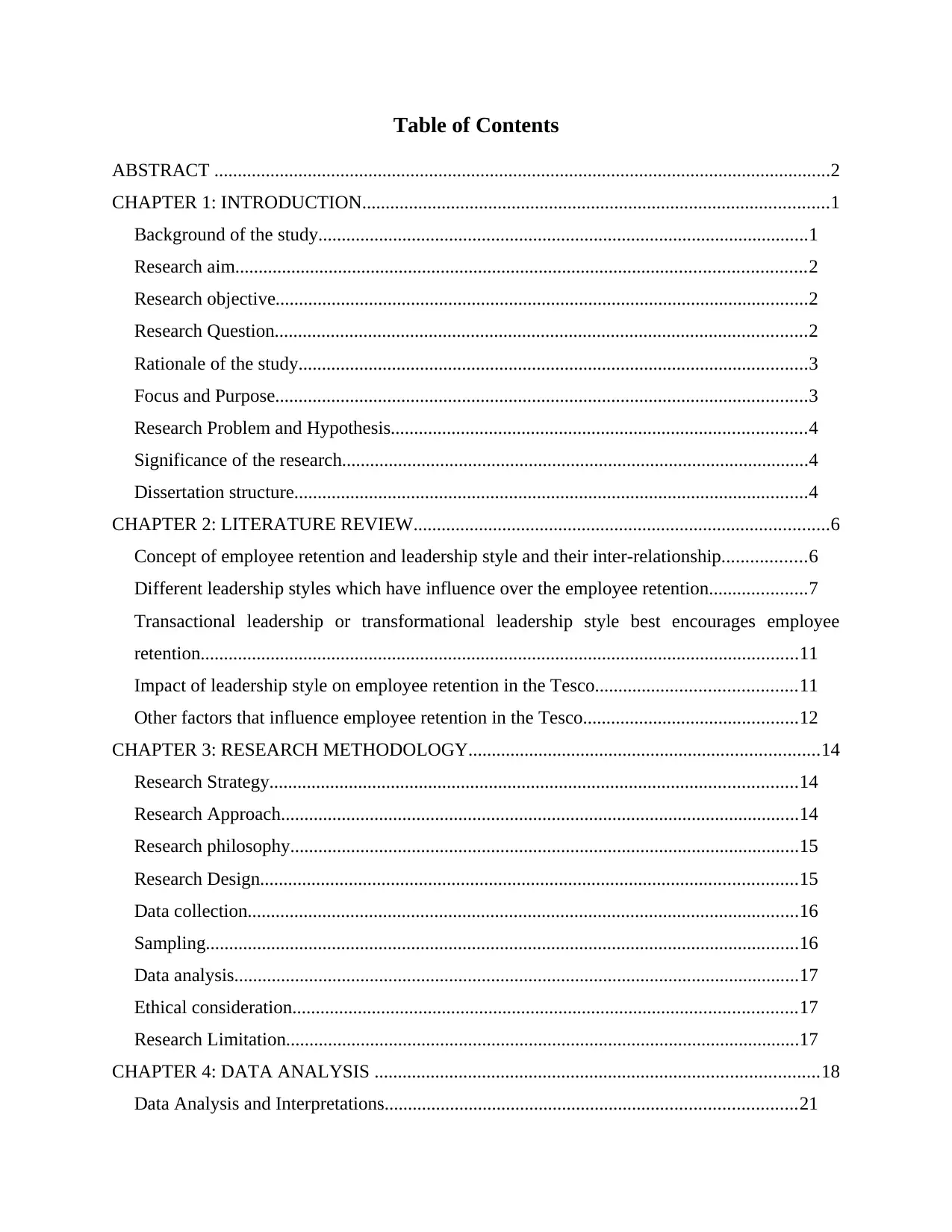
Table of Contents
ABSTRACT ....................................................................................................................................2
CHAPTER 1: INTRODUCTION....................................................................................................1
Background of the study.........................................................................................................1
Research aim..........................................................................................................................2
Research objective..................................................................................................................2
Research Question..................................................................................................................2
Rationale of the study.............................................................................................................3
Focus and Purpose..................................................................................................................3
Research Problem and Hypothesis.........................................................................................4
Significance of the research....................................................................................................4
Dissertation structure..............................................................................................................4
CHAPTER 2: LITERATURE REVIEW.........................................................................................6
Concept of employee retention and leadership style and their inter-relationship..................6
Different leadership styles which have influence over the employee retention.....................7
Transactional leadership or transformational leadership style best encourages employee
retention................................................................................................................................11
Impact of leadership style on employee retention in the Tesco...........................................11
Other factors that influence employee retention in the Tesco..............................................12
CHAPTER 3: RESEARCH METHODOLOGY...........................................................................14
Research Strategy.................................................................................................................14
Research Approach...............................................................................................................14
Research philosophy.............................................................................................................15
Research Design...................................................................................................................15
Data collection......................................................................................................................16
Sampling...............................................................................................................................16
Data analysis.........................................................................................................................17
Ethical consideration............................................................................................................17
Research Limitation..............................................................................................................17
CHAPTER 4: DATA ANALYSIS ...............................................................................................18
Data Analysis and Interpretations........................................................................................21
ABSTRACT ....................................................................................................................................2
CHAPTER 1: INTRODUCTION....................................................................................................1
Background of the study.........................................................................................................1
Research aim..........................................................................................................................2
Research objective..................................................................................................................2
Research Question..................................................................................................................2
Rationale of the study.............................................................................................................3
Focus and Purpose..................................................................................................................3
Research Problem and Hypothesis.........................................................................................4
Significance of the research....................................................................................................4
Dissertation structure..............................................................................................................4
CHAPTER 2: LITERATURE REVIEW.........................................................................................6
Concept of employee retention and leadership style and their inter-relationship..................6
Different leadership styles which have influence over the employee retention.....................7
Transactional leadership or transformational leadership style best encourages employee
retention................................................................................................................................11
Impact of leadership style on employee retention in the Tesco...........................................11
Other factors that influence employee retention in the Tesco..............................................12
CHAPTER 3: RESEARCH METHODOLOGY...........................................................................14
Research Strategy.................................................................................................................14
Research Approach...............................................................................................................14
Research philosophy.............................................................................................................15
Research Design...................................................................................................................15
Data collection......................................................................................................................16
Sampling...............................................................................................................................16
Data analysis.........................................................................................................................17
Ethical consideration............................................................................................................17
Research Limitation..............................................................................................................17
CHAPTER 4: DATA ANALYSIS ...............................................................................................18
Data Analysis and Interpretations........................................................................................21
Paraphrase This Document
Need a fresh take? Get an instant paraphrase of this document with our AI Paraphraser
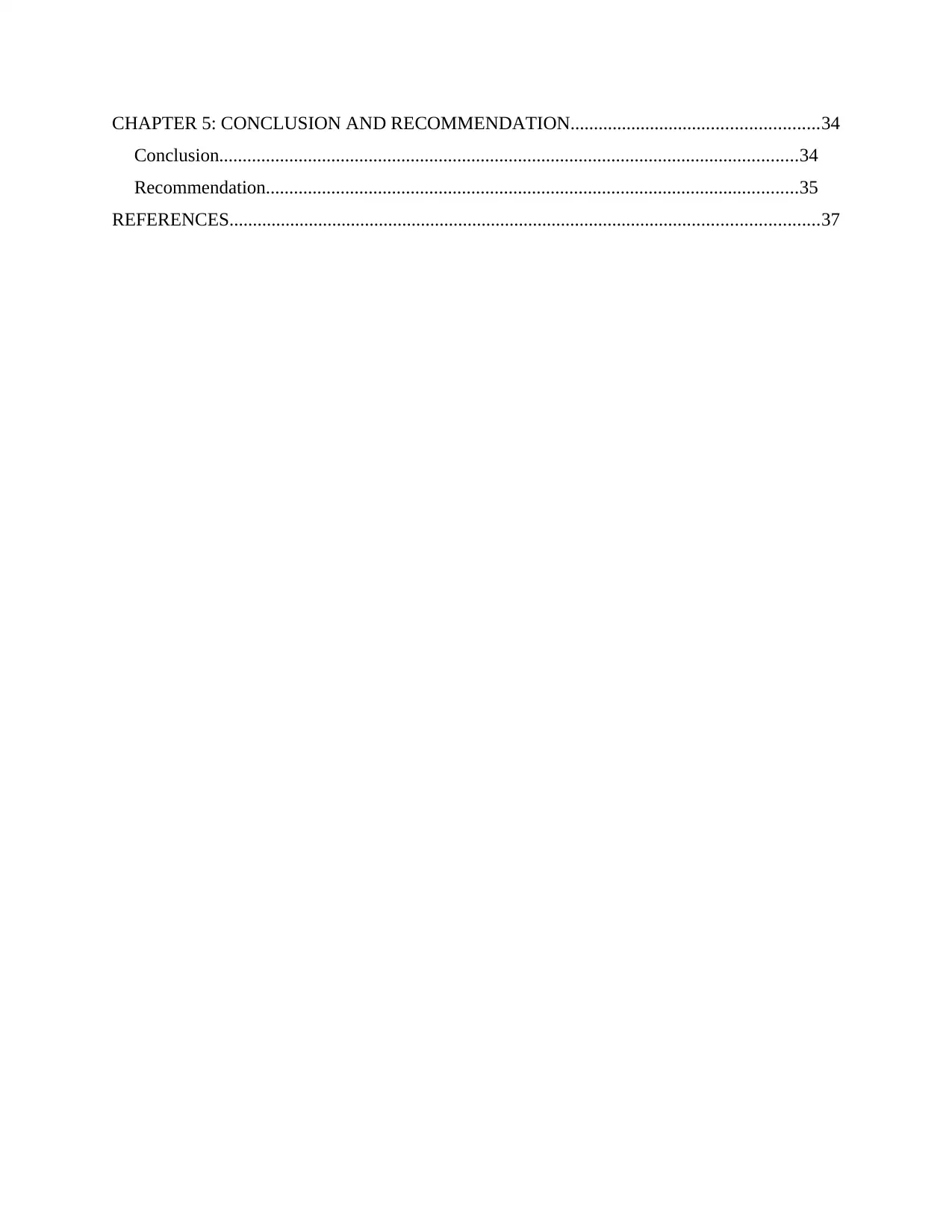
CHAPTER 5: CONCLUSION AND RECOMMENDATION.....................................................34
Conclusion............................................................................................................................34
Recommendation..................................................................................................................35
REFERENCES..............................................................................................................................37
Conclusion............................................................................................................................34
Recommendation..................................................................................................................35
REFERENCES..............................................................................................................................37
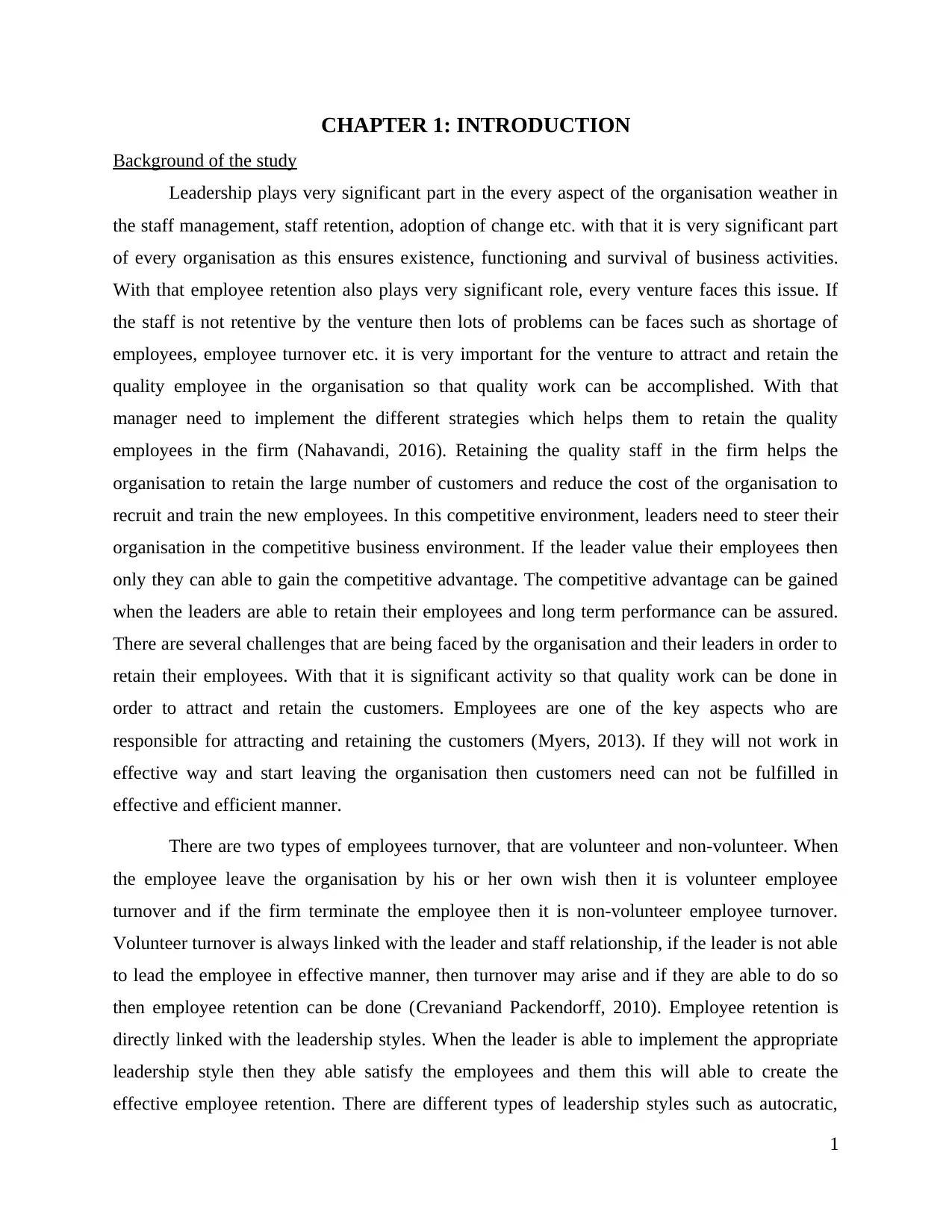
CHAPTER 1: INTRODUCTION
Background of the study
Leadership plays very significant part in the every aspect of the organisation weather in
the staff management, staff retention, adoption of change etc. with that it is very significant part
of every organisation as this ensures existence, functioning and survival of business activities.
With that employee retention also plays very significant role, every venture faces this issue. If
the staff is not retentive by the venture then lots of problems can be faces such as shortage of
employees, employee turnover etc. it is very important for the venture to attract and retain the
quality employee in the organisation so that quality work can be accomplished. With that
manager need to implement the different strategies which helps them to retain the quality
employees in the firm (Nahavandi, 2016). Retaining the quality staff in the firm helps the
organisation to retain the large number of customers and reduce the cost of the organisation to
recruit and train the new employees. In this competitive environment, leaders need to steer their
organisation in the competitive business environment. If the leader value their employees then
only they can able to gain the competitive advantage. The competitive advantage can be gained
when the leaders are able to retain their employees and long term performance can be assured.
There are several challenges that are being faced by the organisation and their leaders in order to
retain their employees. With that it is significant activity so that quality work can be done in
order to attract and retain the customers. Employees are one of the key aspects who are
responsible for attracting and retaining the customers (Myers, 2013). If they will not work in
effective way and start leaving the organisation then customers need can not be fulfilled in
effective and efficient manner.
There are two types of employees turnover, that are volunteer and non-volunteer. When
the employee leave the organisation by his or her own wish then it is volunteer employee
turnover and if the firm terminate the employee then it is non-volunteer employee turnover.
Volunteer turnover is always linked with the leader and staff relationship, if the leader is not able
to lead the employee in effective manner, then turnover may arise and if they are able to do so
then employee retention can be done (Crevaniand Packendorff, 2010). Employee retention is
directly linked with the leadership styles. When the leader is able to implement the appropriate
leadership style then they able satisfy the employees and them this will able to create the
effective employee retention. There are different types of leadership styles such as autocratic,
1
Background of the study
Leadership plays very significant part in the every aspect of the organisation weather in
the staff management, staff retention, adoption of change etc. with that it is very significant part
of every organisation as this ensures existence, functioning and survival of business activities.
With that employee retention also plays very significant role, every venture faces this issue. If
the staff is not retentive by the venture then lots of problems can be faces such as shortage of
employees, employee turnover etc. it is very important for the venture to attract and retain the
quality employee in the organisation so that quality work can be accomplished. With that
manager need to implement the different strategies which helps them to retain the quality
employees in the firm (Nahavandi, 2016). Retaining the quality staff in the firm helps the
organisation to retain the large number of customers and reduce the cost of the organisation to
recruit and train the new employees. In this competitive environment, leaders need to steer their
organisation in the competitive business environment. If the leader value their employees then
only they can able to gain the competitive advantage. The competitive advantage can be gained
when the leaders are able to retain their employees and long term performance can be assured.
There are several challenges that are being faced by the organisation and their leaders in order to
retain their employees. With that it is significant activity so that quality work can be done in
order to attract and retain the customers. Employees are one of the key aspects who are
responsible for attracting and retaining the customers (Myers, 2013). If they will not work in
effective way and start leaving the organisation then customers need can not be fulfilled in
effective and efficient manner.
There are two types of employees turnover, that are volunteer and non-volunteer. When
the employee leave the organisation by his or her own wish then it is volunteer employee
turnover and if the firm terminate the employee then it is non-volunteer employee turnover.
Volunteer turnover is always linked with the leader and staff relationship, if the leader is not able
to lead the employee in effective manner, then turnover may arise and if they are able to do so
then employee retention can be done (Crevaniand Packendorff, 2010). Employee retention is
directly linked with the leadership styles. When the leader is able to implement the appropriate
leadership style then they able satisfy the employees and them this will able to create the
effective employee retention. There are different types of leadership styles such as autocratic,
1
⊘ This is a preview!⊘
Do you want full access?
Subscribe today to unlock all pages.

Trusted by 1+ million students worldwide
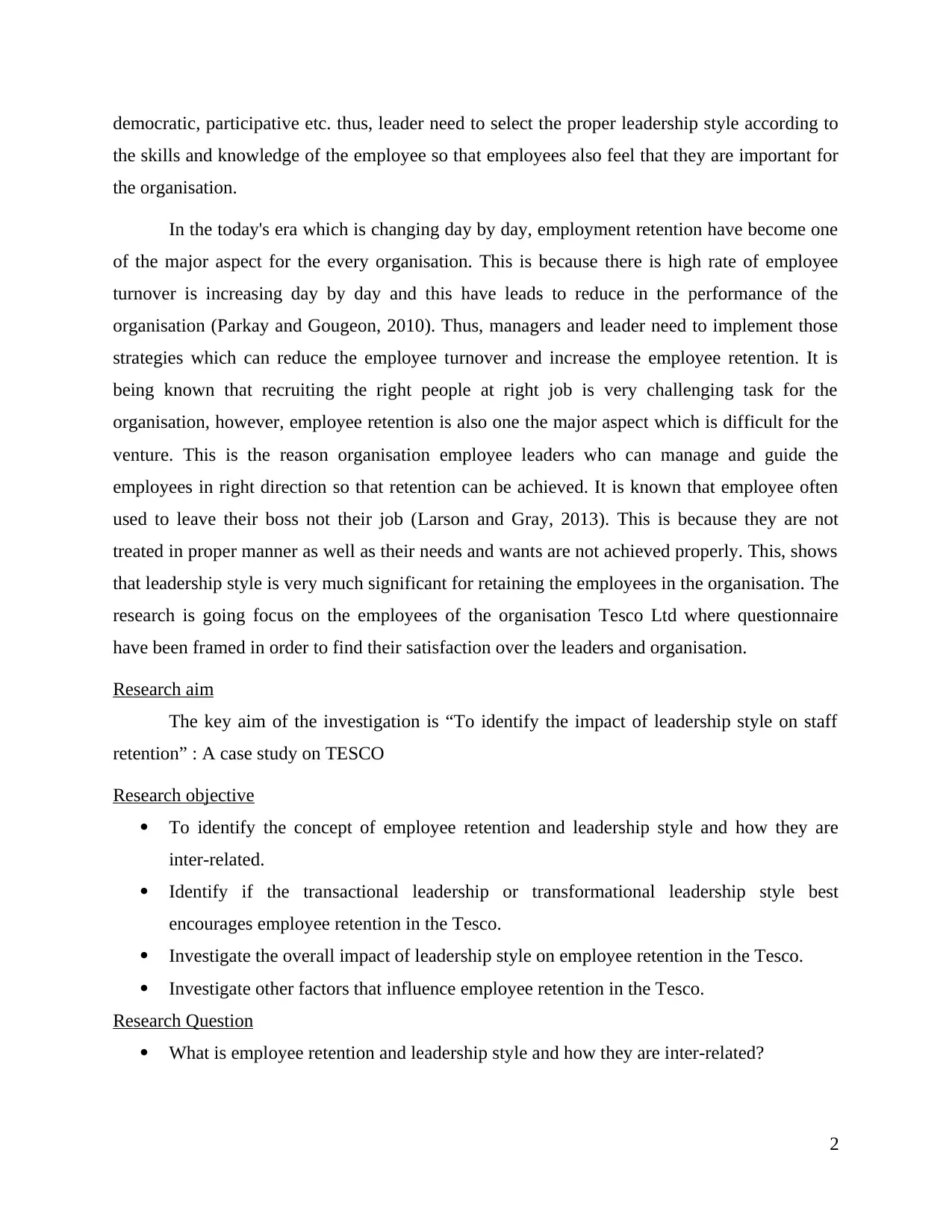
democratic, participative etc. thus, leader need to select the proper leadership style according to
the skills and knowledge of the employee so that employees also feel that they are important for
the organisation.
In the today's era which is changing day by day, employment retention have become one
of the major aspect for the every organisation. This is because there is high rate of employee
turnover is increasing day by day and this have leads to reduce in the performance of the
organisation (Parkay and Gougeon, 2010). Thus, managers and leader need to implement those
strategies which can reduce the employee turnover and increase the employee retention. It is
being known that recruiting the right people at right job is very challenging task for the
organisation, however, employee retention is also one the major aspect which is difficult for the
venture. This is the reason organisation employee leaders who can manage and guide the
employees in right direction so that retention can be achieved. It is known that employee often
used to leave their boss not their job (Larson and Gray, 2013). This is because they are not
treated in proper manner as well as their needs and wants are not achieved properly. This, shows
that leadership style is very much significant for retaining the employees in the organisation. The
research is going focus on the employees of the organisation Tesco Ltd where questionnaire
have been framed in order to find their satisfaction over the leaders and organisation.
Research aim
The key aim of the investigation is “To identify the impact of leadership style on staff
retention” : A case study on TESCO
Research objective
To identify the concept of employee retention and leadership style and how they are
inter-related.
Identify if the transactional leadership or transformational leadership style best
encourages employee retention in the Tesco.
Investigate the overall impact of leadership style on employee retention in the Tesco.
Investigate other factors that influence employee retention in the Tesco.
Research Question
What is employee retention and leadership style and how they are inter-related?
2
the skills and knowledge of the employee so that employees also feel that they are important for
the organisation.
In the today's era which is changing day by day, employment retention have become one
of the major aspect for the every organisation. This is because there is high rate of employee
turnover is increasing day by day and this have leads to reduce in the performance of the
organisation (Parkay and Gougeon, 2010). Thus, managers and leader need to implement those
strategies which can reduce the employee turnover and increase the employee retention. It is
being known that recruiting the right people at right job is very challenging task for the
organisation, however, employee retention is also one the major aspect which is difficult for the
venture. This is the reason organisation employee leaders who can manage and guide the
employees in right direction so that retention can be achieved. It is known that employee often
used to leave their boss not their job (Larson and Gray, 2013). This is because they are not
treated in proper manner as well as their needs and wants are not achieved properly. This, shows
that leadership style is very much significant for retaining the employees in the organisation. The
research is going focus on the employees of the organisation Tesco Ltd where questionnaire
have been framed in order to find their satisfaction over the leaders and organisation.
Research aim
The key aim of the investigation is “To identify the impact of leadership style on staff
retention” : A case study on TESCO
Research objective
To identify the concept of employee retention and leadership style and how they are
inter-related.
Identify if the transactional leadership or transformational leadership style best
encourages employee retention in the Tesco.
Investigate the overall impact of leadership style on employee retention in the Tesco.
Investigate other factors that influence employee retention in the Tesco.
Research Question
What is employee retention and leadership style and how they are inter-related?
2
Paraphrase This Document
Need a fresh take? Get an instant paraphrase of this document with our AI Paraphraser
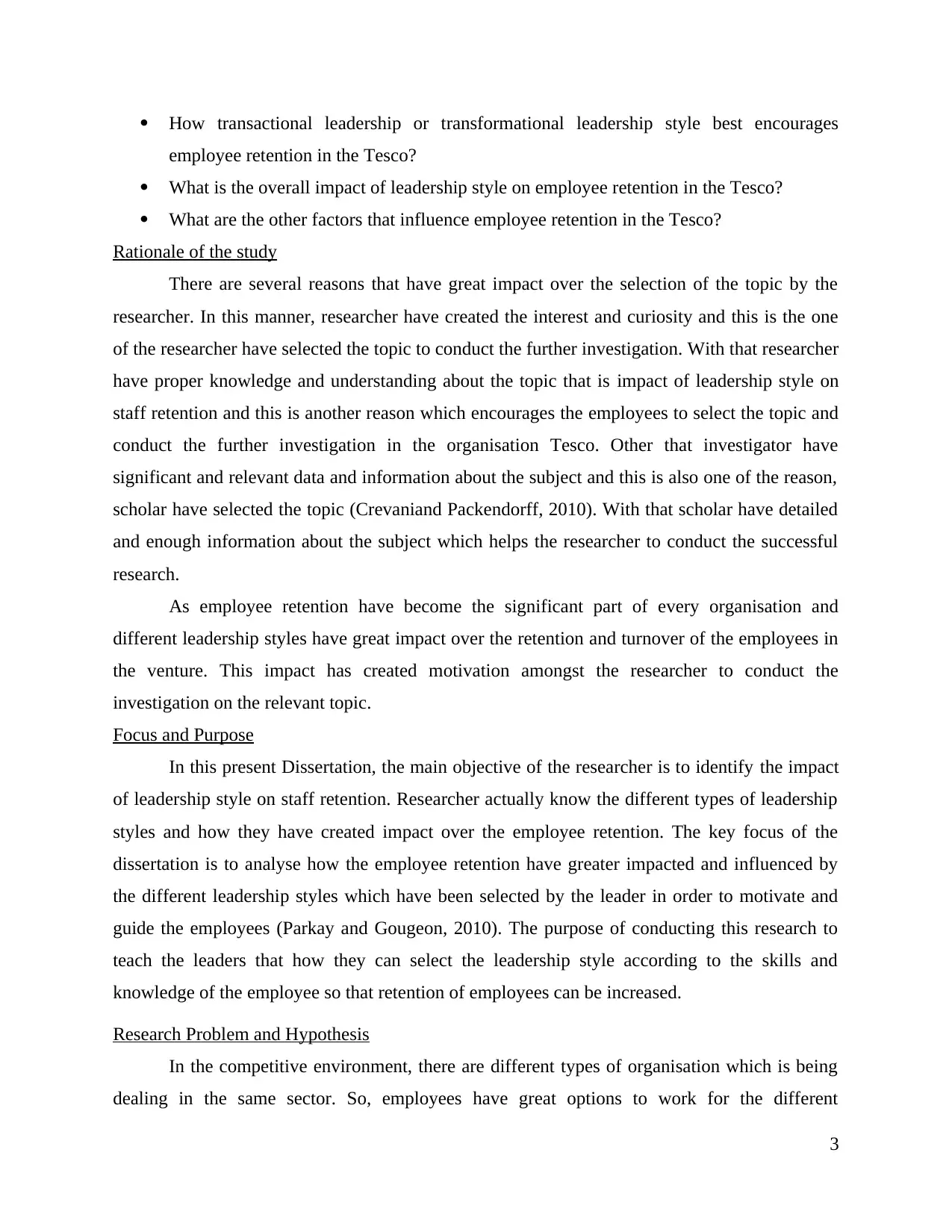
How transactional leadership or transformational leadership style best encourages
employee retention in the Tesco?
What is the overall impact of leadership style on employee retention in the Tesco?
What are the other factors that influence employee retention in the Tesco?
Rationale of the study
There are several reasons that have great impact over the selection of the topic by the
researcher. In this manner, researcher have created the interest and curiosity and this is the one
of the researcher have selected the topic to conduct the further investigation. With that researcher
have proper knowledge and understanding about the topic that is impact of leadership style on
staff retention and this is another reason which encourages the employees to select the topic and
conduct the further investigation in the organisation Tesco. Other that investigator have
significant and relevant data and information about the subject and this is also one of the reason,
scholar have selected the topic (Crevaniand Packendorff, 2010). With that scholar have detailed
and enough information about the subject which helps the researcher to conduct the successful
research.
As employee retention have become the significant part of every organisation and
different leadership styles have great impact over the retention and turnover of the employees in
the venture. This impact has created motivation amongst the researcher to conduct the
investigation on the relevant topic.
Focus and Purpose
In this present Dissertation, the main objective of the researcher is to identify the impact
of leadership style on staff retention. Researcher actually know the different types of leadership
styles and how they have created impact over the employee retention. The key focus of the
dissertation is to analyse how the employee retention have greater impacted and influenced by
the different leadership styles which have been selected by the leader in order to motivate and
guide the employees (Parkay and Gougeon, 2010). The purpose of conducting this research to
teach the leaders that how they can select the leadership style according to the skills and
knowledge of the employee so that retention of employees can be increased.
Research Problem and Hypothesis
In the competitive environment, there are different types of organisation which is being
dealing in the same sector. So, employees have great options to work for the different
3
employee retention in the Tesco?
What is the overall impact of leadership style on employee retention in the Tesco?
What are the other factors that influence employee retention in the Tesco?
Rationale of the study
There are several reasons that have great impact over the selection of the topic by the
researcher. In this manner, researcher have created the interest and curiosity and this is the one
of the researcher have selected the topic to conduct the further investigation. With that researcher
have proper knowledge and understanding about the topic that is impact of leadership style on
staff retention and this is another reason which encourages the employees to select the topic and
conduct the further investigation in the organisation Tesco. Other that investigator have
significant and relevant data and information about the subject and this is also one of the reason,
scholar have selected the topic (Crevaniand Packendorff, 2010). With that scholar have detailed
and enough information about the subject which helps the researcher to conduct the successful
research.
As employee retention have become the significant part of every organisation and
different leadership styles have great impact over the retention and turnover of the employees in
the venture. This impact has created motivation amongst the researcher to conduct the
investigation on the relevant topic.
Focus and Purpose
In this present Dissertation, the main objective of the researcher is to identify the impact
of leadership style on staff retention. Researcher actually know the different types of leadership
styles and how they have created impact over the employee retention. The key focus of the
dissertation is to analyse how the employee retention have greater impacted and influenced by
the different leadership styles which have been selected by the leader in order to motivate and
guide the employees (Parkay and Gougeon, 2010). The purpose of conducting this research to
teach the leaders that how they can select the leadership style according to the skills and
knowledge of the employee so that retention of employees can be increased.
Research Problem and Hypothesis
In the competitive environment, there are different types of organisation which is being
dealing in the same sector. So, employees have great options to work for the different
3
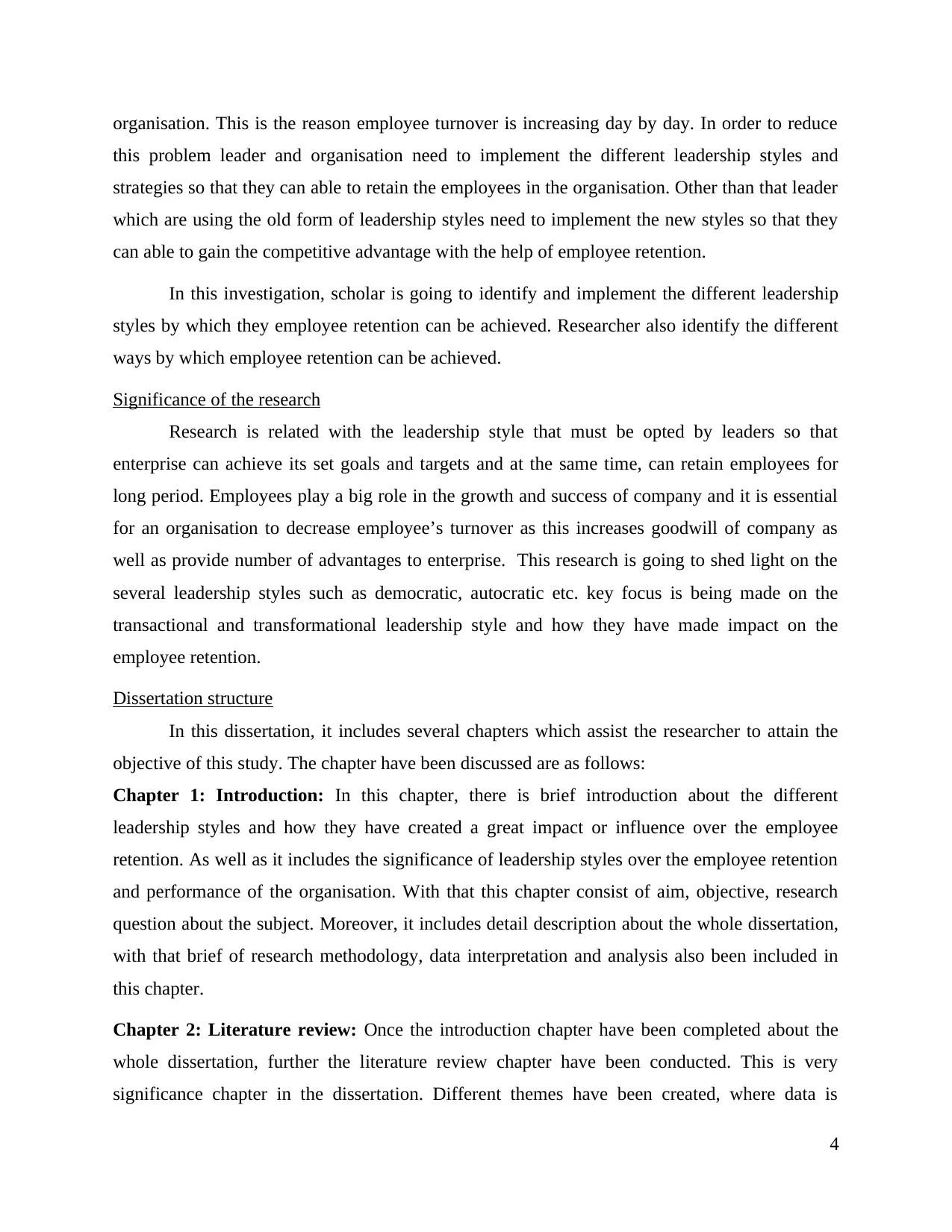
organisation. This is the reason employee turnover is increasing day by day. In order to reduce
this problem leader and organisation need to implement the different leadership styles and
strategies so that they can able to retain the employees in the organisation. Other than that leader
which are using the old form of leadership styles need to implement the new styles so that they
can able to gain the competitive advantage with the help of employee retention.
In this investigation, scholar is going to identify and implement the different leadership
styles by which they employee retention can be achieved. Researcher also identify the different
ways by which employee retention can be achieved.
Significance of the research
Research is related with the leadership style that must be opted by leaders so that
enterprise can achieve its set goals and targets and at the same time, can retain employees for
long period. Employees play a big role in the growth and success of company and it is essential
for an organisation to decrease employee’s turnover as this increases goodwill of company as
well as provide number of advantages to enterprise. This research is going to shed light on the
several leadership styles such as democratic, autocratic etc. key focus is being made on the
transactional and transformational leadership style and how they have made impact on the
employee retention.
Dissertation structure
In this dissertation, it includes several chapters which assist the researcher to attain the
objective of this study. The chapter have been discussed are as follows:
Chapter 1: Introduction: In this chapter, there is brief introduction about the different
leadership styles and how they have created a great impact or influence over the employee
retention. As well as it includes the significance of leadership styles over the employee retention
and performance of the organisation. With that this chapter consist of aim, objective, research
question about the subject. Moreover, it includes detail description about the whole dissertation,
with that brief of research methodology, data interpretation and analysis also been included in
this chapter.
Chapter 2: Literature review: Once the introduction chapter have been completed about the
whole dissertation, further the literature review chapter have been conducted. This is very
significance chapter in the dissertation. Different themes have been created, where data is
4
this problem leader and organisation need to implement the different leadership styles and
strategies so that they can able to retain the employees in the organisation. Other than that leader
which are using the old form of leadership styles need to implement the new styles so that they
can able to gain the competitive advantage with the help of employee retention.
In this investigation, scholar is going to identify and implement the different leadership
styles by which they employee retention can be achieved. Researcher also identify the different
ways by which employee retention can be achieved.
Significance of the research
Research is related with the leadership style that must be opted by leaders so that
enterprise can achieve its set goals and targets and at the same time, can retain employees for
long period. Employees play a big role in the growth and success of company and it is essential
for an organisation to decrease employee’s turnover as this increases goodwill of company as
well as provide number of advantages to enterprise. This research is going to shed light on the
several leadership styles such as democratic, autocratic etc. key focus is being made on the
transactional and transformational leadership style and how they have made impact on the
employee retention.
Dissertation structure
In this dissertation, it includes several chapters which assist the researcher to attain the
objective of this study. The chapter have been discussed are as follows:
Chapter 1: Introduction: In this chapter, there is brief introduction about the different
leadership styles and how they have created a great impact or influence over the employee
retention. As well as it includes the significance of leadership styles over the employee retention
and performance of the organisation. With that this chapter consist of aim, objective, research
question about the subject. Moreover, it includes detail description about the whole dissertation,
with that brief of research methodology, data interpretation and analysis also been included in
this chapter.
Chapter 2: Literature review: Once the introduction chapter have been completed about the
whole dissertation, further the literature review chapter have been conducted. This is very
significance chapter in the dissertation. Different themes have been created, where data is
4
⊘ This is a preview!⊘
Do you want full access?
Subscribe today to unlock all pages.

Trusted by 1+ million students worldwide
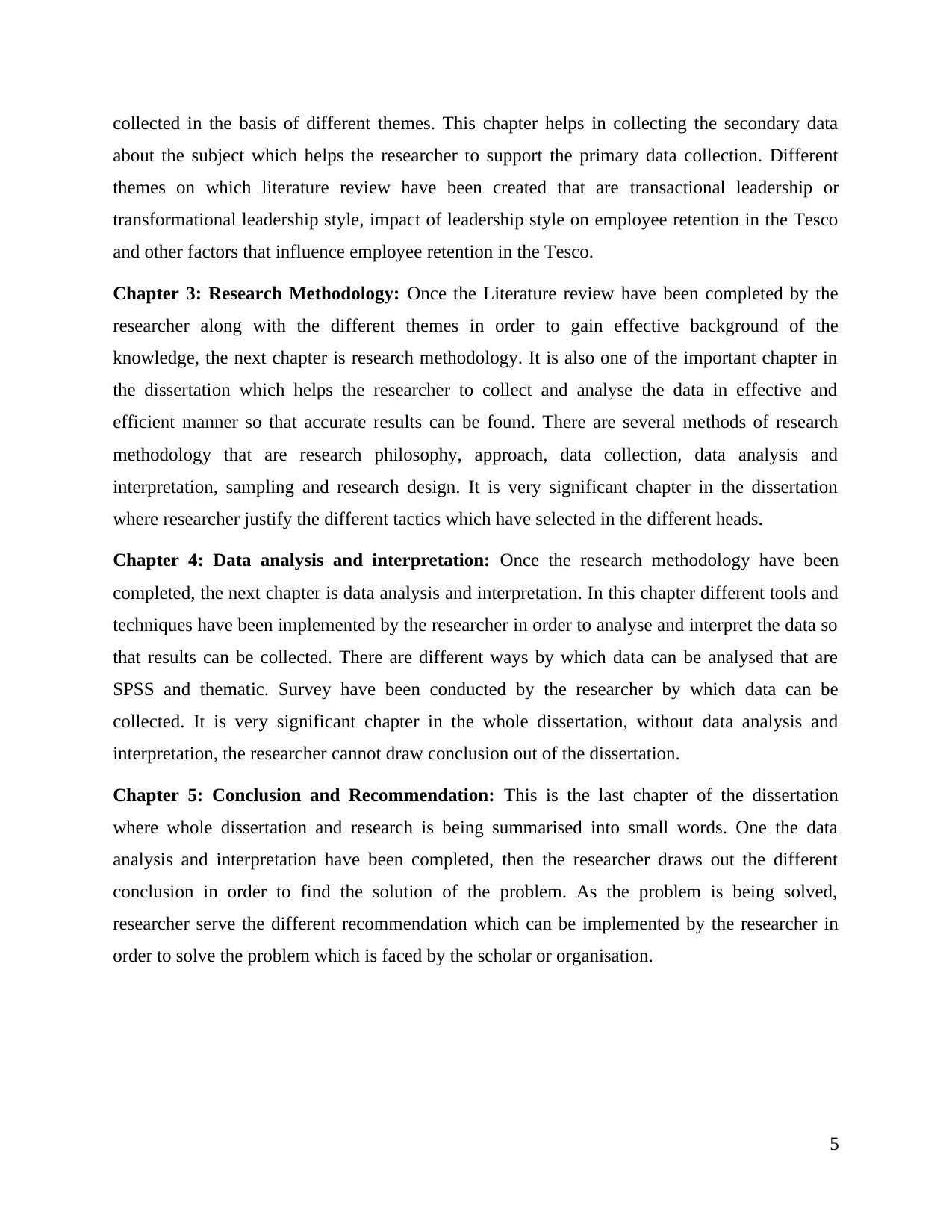
collected in the basis of different themes. This chapter helps in collecting the secondary data
about the subject which helps the researcher to support the primary data collection. Different
themes on which literature review have been created that are transactional leadership or
transformational leadership style, impact of leadership style on employee retention in the Tesco
and other factors that influence employee retention in the Tesco.
Chapter 3: Research Methodology: Once the Literature review have been completed by the
researcher along with the different themes in order to gain effective background of the
knowledge, the next chapter is research methodology. It is also one of the important chapter in
the dissertation which helps the researcher to collect and analyse the data in effective and
efficient manner so that accurate results can be found. There are several methods of research
methodology that are research philosophy, approach, data collection, data analysis and
interpretation, sampling and research design. It is very significant chapter in the dissertation
where researcher justify the different tactics which have selected in the different heads.
Chapter 4: Data analysis and interpretation: Once the research methodology have been
completed, the next chapter is data analysis and interpretation. In this chapter different tools and
techniques have been implemented by the researcher in order to analyse and interpret the data so
that results can be collected. There are different ways by which data can be analysed that are
SPSS and thematic. Survey have been conducted by the researcher by which data can be
collected. It is very significant chapter in the whole dissertation, without data analysis and
interpretation, the researcher cannot draw conclusion out of the dissertation.
Chapter 5: Conclusion and Recommendation: This is the last chapter of the dissertation
where whole dissertation and research is being summarised into small words. One the data
analysis and interpretation have been completed, then the researcher draws out the different
conclusion in order to find the solution of the problem. As the problem is being solved,
researcher serve the different recommendation which can be implemented by the researcher in
order to solve the problem which is faced by the scholar or organisation.
5
about the subject which helps the researcher to support the primary data collection. Different
themes on which literature review have been created that are transactional leadership or
transformational leadership style, impact of leadership style on employee retention in the Tesco
and other factors that influence employee retention in the Tesco.
Chapter 3: Research Methodology: Once the Literature review have been completed by the
researcher along with the different themes in order to gain effective background of the
knowledge, the next chapter is research methodology. It is also one of the important chapter in
the dissertation which helps the researcher to collect and analyse the data in effective and
efficient manner so that accurate results can be found. There are several methods of research
methodology that are research philosophy, approach, data collection, data analysis and
interpretation, sampling and research design. It is very significant chapter in the dissertation
where researcher justify the different tactics which have selected in the different heads.
Chapter 4: Data analysis and interpretation: Once the research methodology have been
completed, the next chapter is data analysis and interpretation. In this chapter different tools and
techniques have been implemented by the researcher in order to analyse and interpret the data so
that results can be collected. There are different ways by which data can be analysed that are
SPSS and thematic. Survey have been conducted by the researcher by which data can be
collected. It is very significant chapter in the whole dissertation, without data analysis and
interpretation, the researcher cannot draw conclusion out of the dissertation.
Chapter 5: Conclusion and Recommendation: This is the last chapter of the dissertation
where whole dissertation and research is being summarised into small words. One the data
analysis and interpretation have been completed, then the researcher draws out the different
conclusion in order to find the solution of the problem. As the problem is being solved,
researcher serve the different recommendation which can be implemented by the researcher in
order to solve the problem which is faced by the scholar or organisation.
5
Paraphrase This Document
Need a fresh take? Get an instant paraphrase of this document with our AI Paraphraser
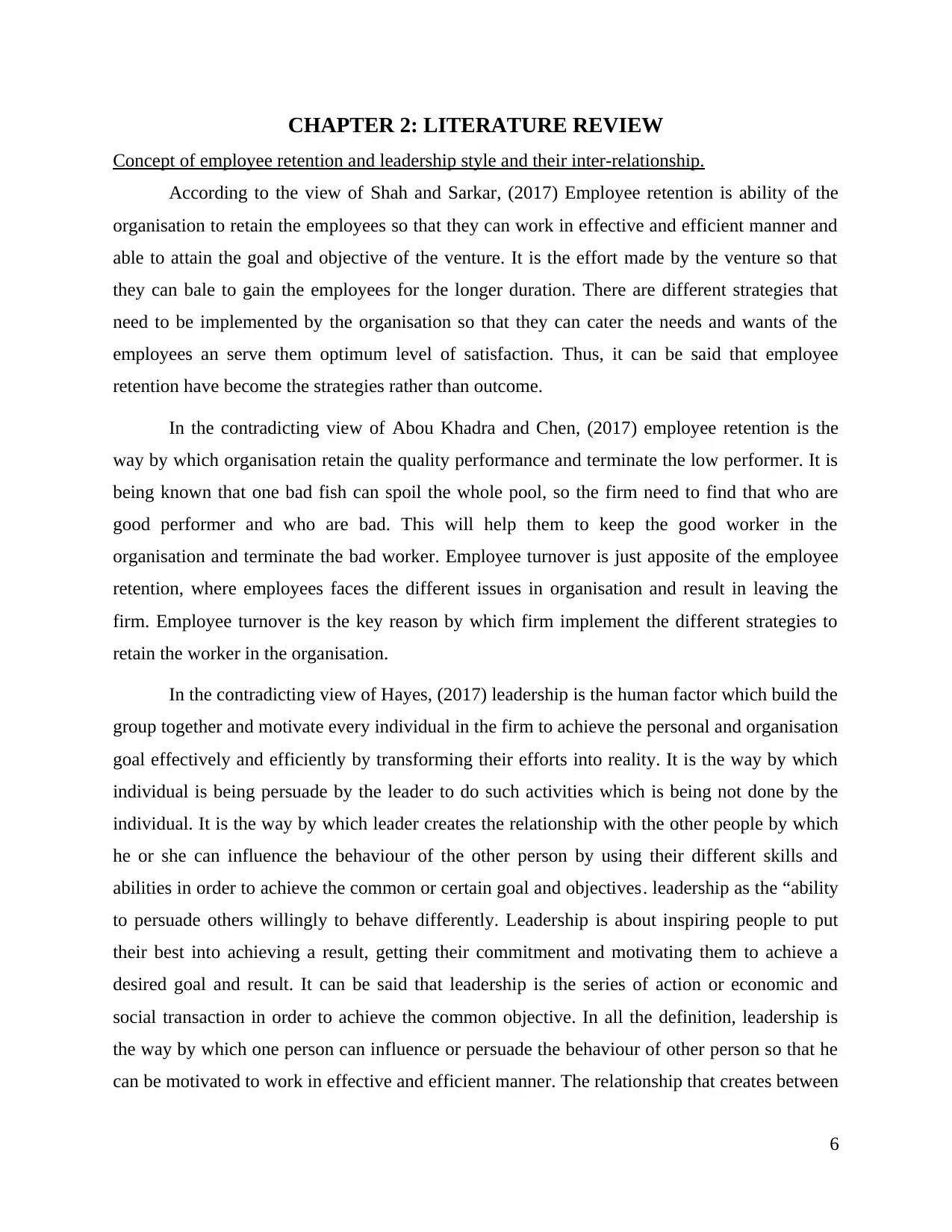
CHAPTER 2: LITERATURE REVIEW
Concept of employee retention and leadership style and their inter-relationship.
According to the view of Shah and Sarkar, (2017) Employee retention is ability of the
organisation to retain the employees so that they can work in effective and efficient manner and
able to attain the goal and objective of the venture. It is the effort made by the venture so that
they can bale to gain the employees for the longer duration. There are different strategies that
need to be implemented by the organisation so that they can cater the needs and wants of the
employees an serve them optimum level of satisfaction. Thus, it can be said that employee
retention have become the strategies rather than outcome.
In the contradicting view of Abou Khadra and Chen, (2017) employee retention is the
way by which organisation retain the quality performance and terminate the low performer. It is
being known that one bad fish can spoil the whole pool, so the firm need to find that who are
good performer and who are bad. This will help them to keep the good worker in the
organisation and terminate the bad worker. Employee turnover is just apposite of the employee
retention, where employees faces the different issues in organisation and result in leaving the
firm. Employee turnover is the key reason by which firm implement the different strategies to
retain the worker in the organisation.
In the contradicting view of Hayes, (2017) leadership is the human factor which build the
group together and motivate every individual in the firm to achieve the personal and organisation
goal effectively and efficiently by transforming their efforts into reality. It is the way by which
individual is being persuade by the leader to do such activities which is being not done by the
individual. It is the way by which leader creates the relationship with the other people by which
he or she can influence the behaviour of the other person by using their different skills and
abilities in order to achieve the common or certain goal and objectives. leadership as the “ability
to persuade others willingly to behave differently. Leadership is about inspiring people to put
their best into achieving a result, getting their commitment and motivating them to achieve a
desired goal and result. It can be said that leadership is the series of action or economic and
social transaction in order to achieve the common objective. In all the definition, leadership is
the way by which one person can influence or persuade the behaviour of other person so that he
can be motivated to work in effective and efficient manner. The relationship that creates between
6
Concept of employee retention and leadership style and their inter-relationship.
According to the view of Shah and Sarkar, (2017) Employee retention is ability of the
organisation to retain the employees so that they can work in effective and efficient manner and
able to attain the goal and objective of the venture. It is the effort made by the venture so that
they can bale to gain the employees for the longer duration. There are different strategies that
need to be implemented by the organisation so that they can cater the needs and wants of the
employees an serve them optimum level of satisfaction. Thus, it can be said that employee
retention have become the strategies rather than outcome.
In the contradicting view of Abou Khadra and Chen, (2017) employee retention is the
way by which organisation retain the quality performance and terminate the low performer. It is
being known that one bad fish can spoil the whole pool, so the firm need to find that who are
good performer and who are bad. This will help them to keep the good worker in the
organisation and terminate the bad worker. Employee turnover is just apposite of the employee
retention, where employees faces the different issues in organisation and result in leaving the
firm. Employee turnover is the key reason by which firm implement the different strategies to
retain the worker in the organisation.
In the contradicting view of Hayes, (2017) leadership is the human factor which build the
group together and motivate every individual in the firm to achieve the personal and organisation
goal effectively and efficiently by transforming their efforts into reality. It is the way by which
individual is being persuade by the leader to do such activities which is being not done by the
individual. It is the way by which leader creates the relationship with the other people by which
he or she can influence the behaviour of the other person by using their different skills and
abilities in order to achieve the common or certain goal and objectives. leadership as the “ability
to persuade others willingly to behave differently. Leadership is about inspiring people to put
their best into achieving a result, getting their commitment and motivating them to achieve a
desired goal and result. It can be said that leadership is the series of action or economic and
social transaction in order to achieve the common objective. In all the definition, leadership is
the way by which one person can influence or persuade the behaviour of other person so that he
can be motivated to work in effective and efficient manner. The relationship that creates between
6
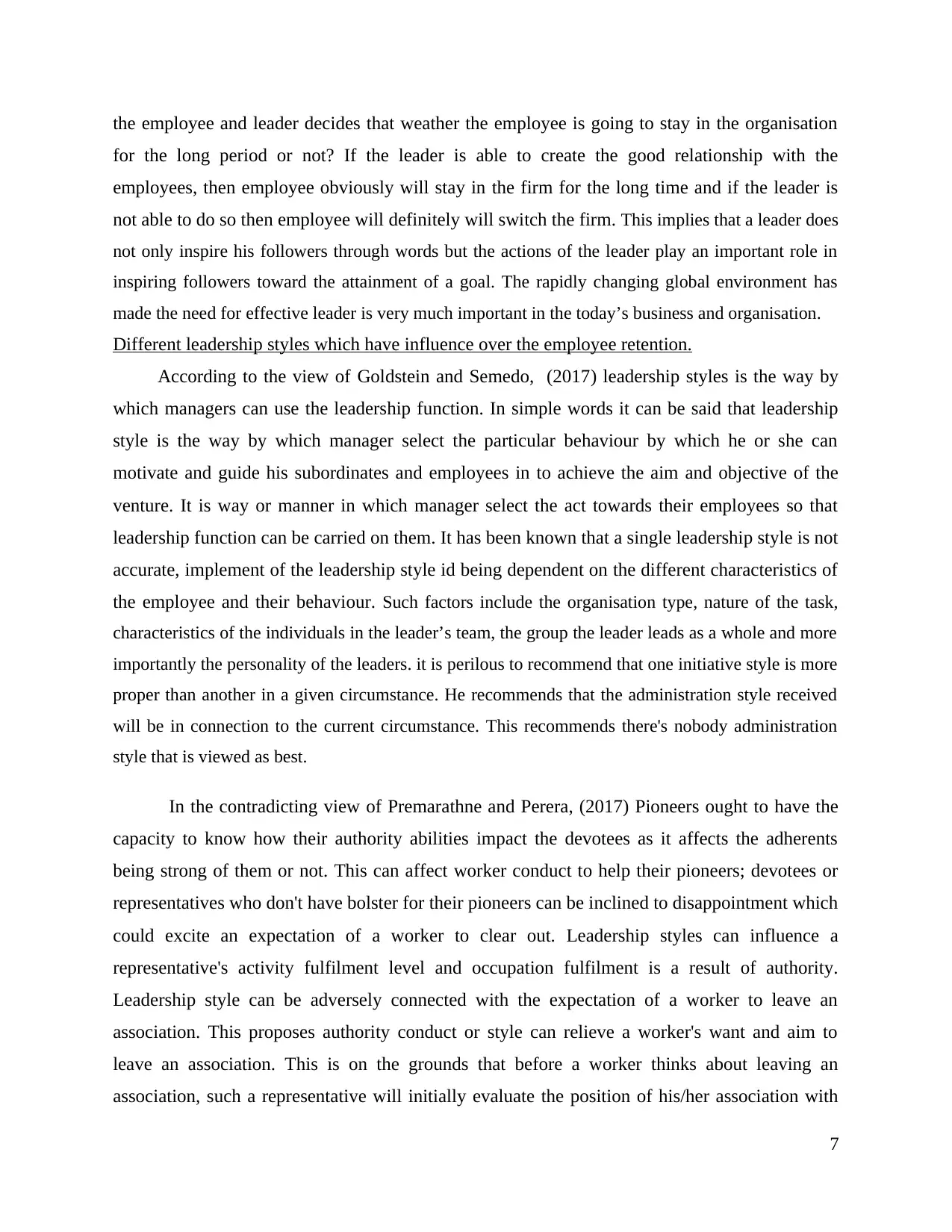
the employee and leader decides that weather the employee is going to stay in the organisation
for the long period or not? If the leader is able to create the good relationship with the
employees, then employee obviously will stay in the firm for the long time and if the leader is
not able to do so then employee will definitely will switch the firm. This implies that a leader does
not only inspire his followers through words but the actions of the leader play an important role in
inspiring followers toward the attainment of a goal. The rapidly changing global environment has
made the need for effective leader is very much important in the today’s business and organisation.
Different leadership styles which have influence over the employee retention.
According to the view of Goldstein and Semedo, (2017) leadership styles is the way by
which managers can use the leadership function. In simple words it can be said that leadership
style is the way by which manager select the particular behaviour by which he or she can
motivate and guide his subordinates and employees in to achieve the aim and objective of the
venture. It is way or manner in which manager select the act towards their employees so that
leadership function can be carried on them. It has been known that a single leadership style is not
accurate, implement of the leadership style id being dependent on the different characteristics of
the employee and their behaviour. Such factors include the organisation type, nature of the task,
characteristics of the individuals in the leader’s team, the group the leader leads as a whole and more
importantly the personality of the leaders. it is perilous to recommend that one initiative style is more
proper than another in a given circumstance. He recommends that the administration style received
will be in connection to the current circumstance. This recommends there's nobody administration
style that is viewed as best.
In the contradicting view of Premarathne and Perera, (2017) Pioneers ought to have the
capacity to know how their authority abilities impact the devotees as it affects the adherents
being strong of them or not. This can affect worker conduct to help their pioneers; devotees or
representatives who don't have bolster for their pioneers can be inclined to disappointment which
could excite an expectation of a worker to clear out. Leadership styles can influence a
representative's activity fulfilment level and occupation fulfilment is a result of authority.
Leadership style can be adversely connected with the expectation of a worker to leave an
association. This proposes authority conduct or style can relieve a worker's want and aim to
leave an association. This is on the grounds that before a worker thinks about leaving an
association, such a representative will initially evaluate the position of his/her association with
7
for the long period or not? If the leader is able to create the good relationship with the
employees, then employee obviously will stay in the firm for the long time and if the leader is
not able to do so then employee will definitely will switch the firm. This implies that a leader does
not only inspire his followers through words but the actions of the leader play an important role in
inspiring followers toward the attainment of a goal. The rapidly changing global environment has
made the need for effective leader is very much important in the today’s business and organisation.
Different leadership styles which have influence over the employee retention.
According to the view of Goldstein and Semedo, (2017) leadership styles is the way by
which managers can use the leadership function. In simple words it can be said that leadership
style is the way by which manager select the particular behaviour by which he or she can
motivate and guide his subordinates and employees in to achieve the aim and objective of the
venture. It is way or manner in which manager select the act towards their employees so that
leadership function can be carried on them. It has been known that a single leadership style is not
accurate, implement of the leadership style id being dependent on the different characteristics of
the employee and their behaviour. Such factors include the organisation type, nature of the task,
characteristics of the individuals in the leader’s team, the group the leader leads as a whole and more
importantly the personality of the leaders. it is perilous to recommend that one initiative style is more
proper than another in a given circumstance. He recommends that the administration style received
will be in connection to the current circumstance. This recommends there's nobody administration
style that is viewed as best.
In the contradicting view of Premarathne and Perera, (2017) Pioneers ought to have the
capacity to know how their authority abilities impact the devotees as it affects the adherents
being strong of them or not. This can affect worker conduct to help their pioneers; devotees or
representatives who don't have bolster for their pioneers can be inclined to disappointment which
could excite an expectation of a worker to clear out. Leadership styles can influence a
representative's activity fulfilment level and occupation fulfilment is a result of authority.
Leadership style can be adversely connected with the expectation of a worker to leave an
association. This proposes authority conduct or style can relieve a worker's want and aim to
leave an association. This is on the grounds that before a worker thinks about leaving an
association, such a representative will initially evaluate the position of his/her association with
7
⊘ This is a preview!⊘
Do you want full access?
Subscribe today to unlock all pages.

Trusted by 1+ million students worldwide
1 out of 44
Related Documents
Your All-in-One AI-Powered Toolkit for Academic Success.
+13062052269
info@desklib.com
Available 24*7 on WhatsApp / Email
![[object Object]](/_next/static/media/star-bottom.7253800d.svg)
Unlock your academic potential
Copyright © 2020–2025 A2Z Services. All Rights Reserved. Developed and managed by ZUCOL.





